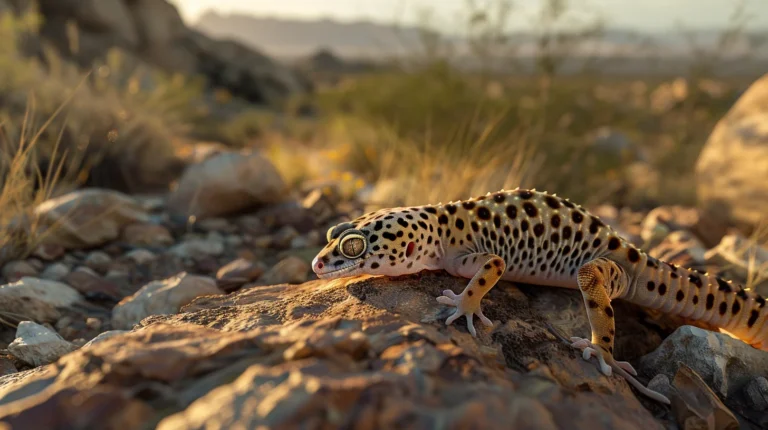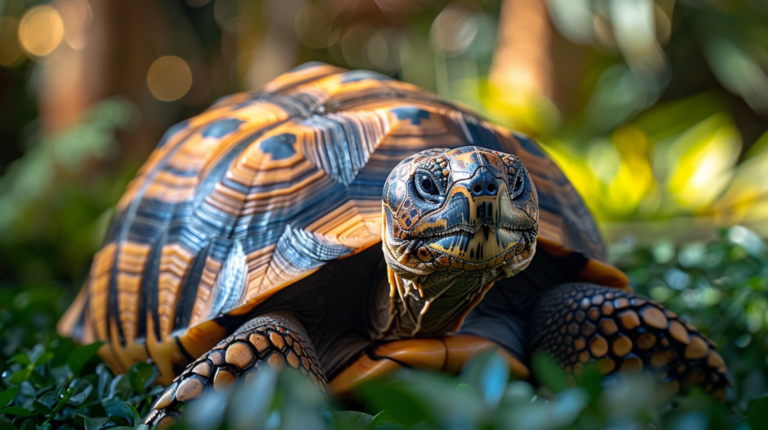Discover the fascinating Mack Snow Leopard Gecko traits, care tips, and breeding insights. Learn why these stunning reptiles make perfect pets for beginners and experts alike.
Table of Contents
The Mack Snow Leopard Gecko stands as one of the most captivating and sought-after morphs in the reptile world. With their striking appearance, docile temperament, and relatively simple care requirements, these remarkable creatures have captured the hearts of both novice and experienced reptile enthusiasts worldwide. Whether you’re considering adding one to your collection or simply curious about these fascinating animals, understanding their unique characteristics is essential for proper care and appreciation.
Named after John Mack, who first developed this morph in the 1990s, the Mack Snow Leopard Gecko represents a significant milestone in selective breeding. These geckos showcase a stunning combination of reduced pigmentation and enhanced contrast that creates their signature “snowy” appearance. Unlike their wild-type cousins, Mack Snow geckos display a remarkable range of colors and patterns that continue to evolve through careful breeding programs.
This comprehensive guide will explore nine essential traits that make the Mack Snow Leopard Gecko truly special, from their distinctive physical characteristics to their behavioral patterns and care requirements. By the end of this article, you’ll have a thorough understanding of what makes these geckos unique and how to provide them with the best possible care.
What Makes the Mack Snow Leopard Gecko Special?

The Mack Snow Leopard Gecko isn’t just another reptile morph – it’s a testament to the art and science of selective breeding. These geckos represent years of dedicated work by breeders who sought to enhance specific traits while maintaining the species’ natural hardiness and temperament.
What sets the Mack Snow apart from standard leopard geckos is their unique genetic makeup. The “Snow” gene is a line-bred trait that affects melanin production, resulting in reduced black pigmentation and enhanced contrast between light and dark areas. This genetic modification doesn’t just affect appearance; it influences various aspects of the gecko’s biology and behavior.
The popularity of Mack Snow Leopard Geckos has grown exponentially over the past two decades. According to reptile trade statistics, snow morphs now account for approximately 15-20% of all leopard gecko sales in the United States, making them one of the most commercially successful morphs in the hobby.
1. Distinctive Snow-White Coloration Pattern
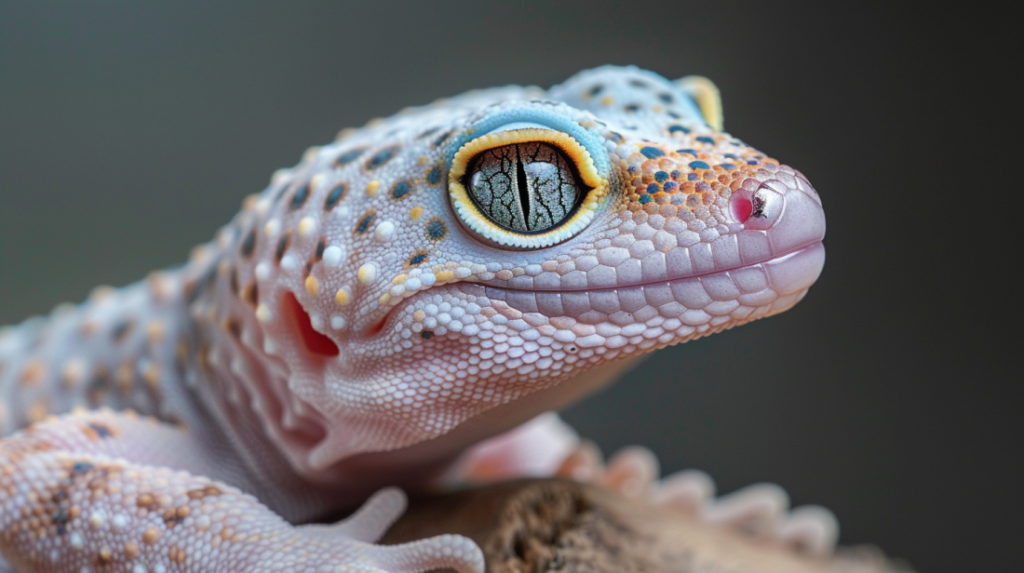
The most immediately recognizable trait of the Mack Snow Leopard Gecko is their stunning coloration. Unlike the typical yellow and black patterns of wild-type leopard geckos, Mack Snows display a beautiful contrast of white, cream, and light gray tones with darker banding.
Understanding the Snow Gene
The snow gene works by reducing melanophore activity – the cells responsible for producing dark pigmentation. This reduction creates the characteristic “washed out” appearance that gives these geckos their name. The gene is incompletely dominant, meaning that heterozygous animals (carrying one copy) show moderate expression, while homozygous animals (carrying two copies) display the most dramatic coloration.
Key characteristics of Mack Snow coloration include:
- Base color: Ranges from pure white to cream or light gray
- Banding patterns: Dark bands appear more muted than in normal morphs
- Eye coloration: Often lighter than standard leopard geckos
- Tail patterns: Distinctive banding that may fade with age
Variations Within the Morph
Not all Mack Snow Leopard Geckos look identical. Several factors influence their final appearance:
Genetic Background: The specific line of Mack Snow affects coloration intensity and pattern distribution. Some lines produce nearly white animals, while others maintain more contrast.
Age-Related Changes: Juvenile Mack Snows often display more vibrant patterns that may fade or intensify as they mature. This process, called “ontogenetic color change,” is particularly pronounced in snow morphs.
Environmental Factors: Temperature, lighting, and stress levels can temporarily affect coloration intensity. Proper husbandry ensures optimal color expression throughout the gecko’s life.
2. Unique Eye Characteristics and Vision
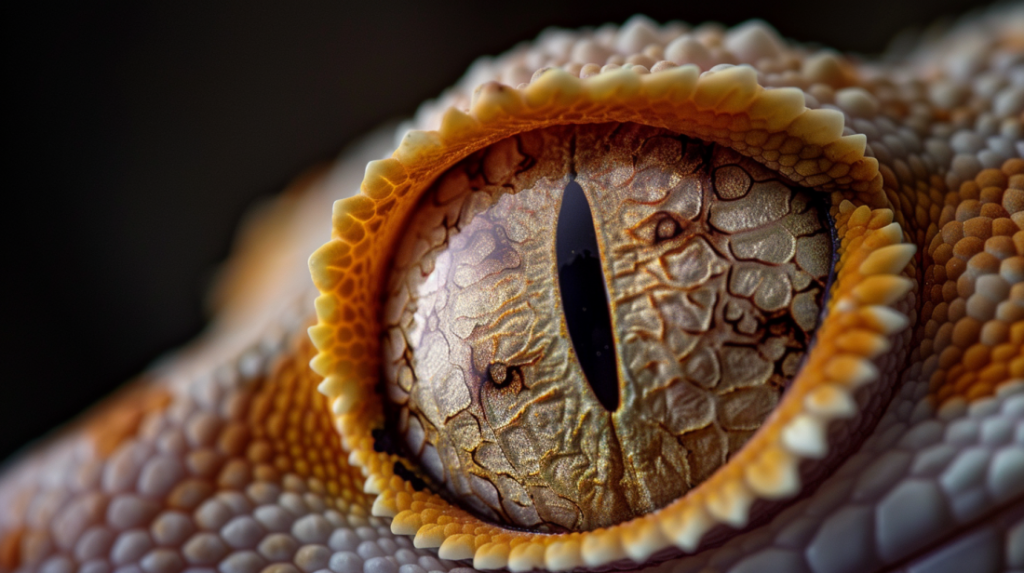
The eyes of a Mack Snow Leopard Gecko tell a fascinating story about their genetics and evolution. These remarkable organs not only contribute to their distinctive appearance but also provide insights into how the snow gene affects sensory development.
Eye Color Variations
Mack Snow geckos exhibit a broader range of eye colors compared to normal leopard geckos. Common variations include:
- Lighter brown to tan: The most common eye color in Mack Snows
- Gray or silver: Less common but highly prized by collectors
- Reduced pigmentation rings: The iris often shows less distinct color banding
Visual Capabilities
Research conducted by herpetologists has shown that leopard geckos, including Mack Snow varieties, possess excellent night vision capabilities. Their eyes contain specialized structures that enhance light sensitivity, making them formidable nocturnal hunters.
Dr. Sarah Henderson, a reptile vision specialist at the University of California, notes: “Leopard geckos have some of the most sophisticated night vision systems among terrestrial reptiles. The snow gene doesn’t appear to significantly impact their visual acuity, though it may slightly reduce light sensitivity in some individuals.”
Health Considerations
While the snow gene generally doesn’t affect eye health, certain breeding combinations can lead to visual impairments. Responsible breeders avoid crossing certain morphs that might produce offspring with compromised vision.
3. Size and Physical Development Patterns
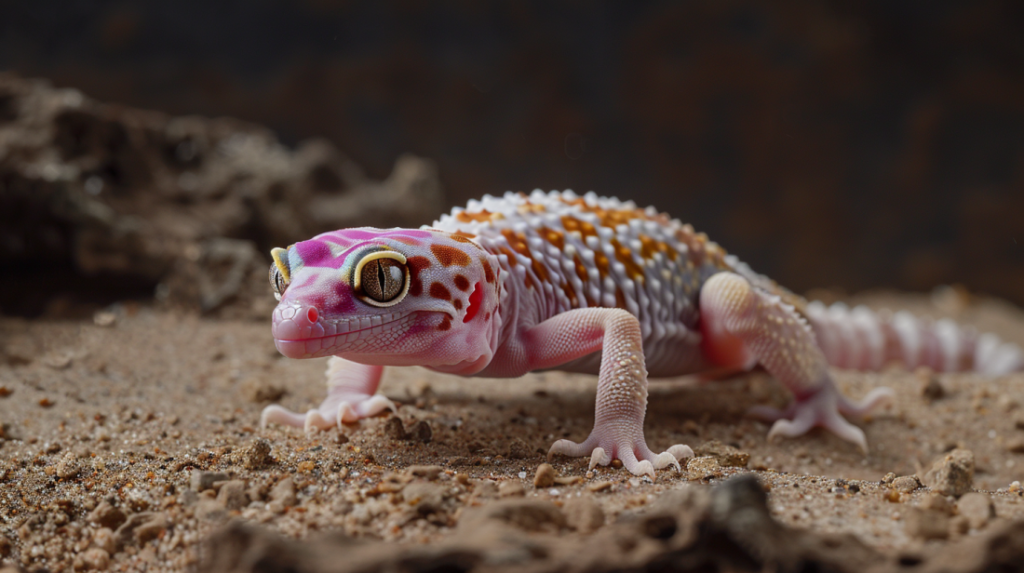
Understanding the growth patterns and physical development of Mack Snow Leopard Geckos is crucial for proper care and health monitoring. These geckos follow predictable development stages, though individual variation is common.
Growth Timeline
| Age | Average Length | Average Weight | Key Developmental Markers |
| Hatchling | 3-4 inches | 2-3 grams | Vivid juvenile patterns |
| 3 months | 4-5 inches | 8-12 grams | Pattern stabilization begins |
| 6 months | 5-6 inches | 15-25 grams | Sexual characteristics emerge |
| 1 year | 6-7 inches | 35-50 grams | Adult coloration developing |
| 2+ years | 7-9 inches | 60-90 grams | Full adult size and pattern |
Sexual Dimorphism
Male and female Mack Snow geckos exhibit distinct physical differences that become apparent as they mature:
Males:
- Broader heads and necks
- More pronounced femoral pores
- Pre-anal pores arranged in a “V” shape
- Generally slightly larger overall size
Females:
- More slender build
- Less prominent pore development
- Broader hips when gravid
- Slightly shorter average length
Factors Affecting Growth
Several environmental and genetic factors influence the development of Mack Snow Leopard Geckos:
Temperature: Consistent temperatures between 75-85°F promote optimal growth rates. Temperature fluctuations can slow development and affect final adult size.
Nutrition: A varied diet rich in appropriately sized insects ensures proper development. Inadequate nutrition during the juvenile phase can result in stunted growth and health issues.
Genetics: Some bloodlines naturally produce larger or smaller adults. Understanding the genetic background helps predict adult size.
4. Temperament and Behavioral Traits
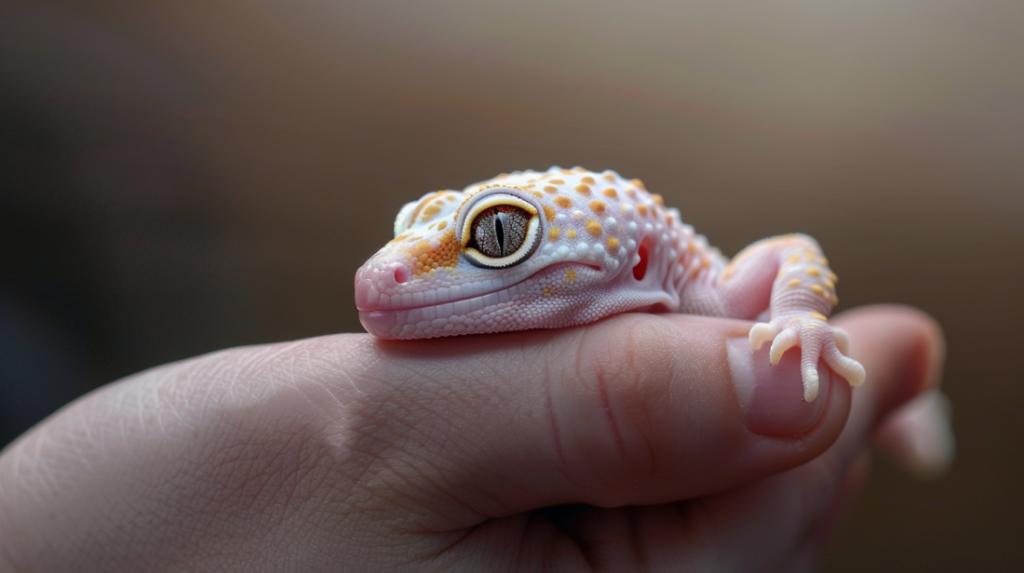
The Mack Snow Leopard Gecko is renowned for its docile and handleable nature, making it an ideal choice for both beginners and experienced keepers. Their behavioral characteristics stem from both their wild ancestry and generations of selective breeding in captivity.
Natural Behavior Patterns
Mack Snow geckos retain many natural behaviors despite their captive-bred origins:
Crepuscular Activity: Most active during dawn and dusk hours, with peak activity occurring in the early evening. This behavior pattern remains consistent regardless of morph.
Territorial Tendencies: Adult males may display territorial behavior, especially during breeding season. This includes tail waving, vocalizations, and occasional aggressive interactions with other males.
Hiding Behavior: Strong instinct to seek secure hiding places during daylight hours. Providing multiple hide options is essential for their psychological well-being.
Handling Characteristics
One of the most appealing aspects of Mack Snow geckos is their tolerance for human interaction:
Stress Response: Generally exhibit minimal stress responses to gentle handling, making them suitable for educational programs and pet interactions.
Bite Tendency: Rarely bite unless severely stressed or threatened. Even when they do bite, their small teeth cause minimal discomfort.
Adaptability: Young geckos typically adapt to handling more readily than adults, though most individuals become comfortable with regular, gentle interaction.
Social Behavior
Understanding social dynamics is crucial for multi-gecko setups:
Housing Compatibility: Adult males should never be housed together due to territorial aggression. Females can often cohabitate successfully with proper space and resources.
Breeding Behavior: During breeding season, males become more active and vocal, often producing chirping sounds to attract females.
Stress Indicators: Changes in appetite, hiding behavior, or aggressive responses may indicate stress or health issues requiring attention.
5. Dietary Requirements and Feeding Behavior

Proper nutrition forms the foundation of Mack Snow Leopard Gecko health and longevity. Understanding their dietary needs and feeding behaviors ensures optimal growth, reproduction, and overall well-being throughout their 15-20 year lifespan.
Natural Feeding Instincts
Mack Snow geckos retain strong predatory instincts that influence their feeding behavior:
Hunt-and-Strike Response: They exhibit rapid striking behavior when presented with moving prey, demonstrating their natural hunting abilities even in captivity.
Prey Size Preference: Instinctively select prey items that are appropriately sized – generally no larger than the width of their head.
Feeding Schedule Adaptation: Can adapt to regular feeding schedules while maintaining natural foraging behaviors when prey is available.
Optimal Diet Composition
A well-balanced diet for Mack Snow geckos includes:
Primary Protein Sources:
- Crickets (40-50% of diet)
- Mealworms (20-30% of diet)
- Dubia roaches (15-20% of diet)
- Waxworms (occasional treats only)
Supplementation Requirements:
- Calcium powder (with D3) dusted on prey 2-3 times weekly
- Multivitamin supplement once weekly
- Gut-loading feeder insects 24-48 hours before feeding
Age-Specific Feeding Guidelines
Juveniles (0-12 months):
- Feed daily with appropriately sized insects
- 5-7 small crickets or equivalent per feeding
- Focus on growth-supporting nutrition
Adults (12+ months):
- Feed every other day or 3-4 times weekly
- 7-10 medium insects or equivalent per feeding
- Maintain body condition without overfeeding
Feeding Behavior Observations
Dr. Michael Rodriguez, a reptile nutritionist, explains: “Leopard geckos, including Mack Snow varieties, demonstrate remarkable feeding efficiency. They can consume up to 15% of their body weight in a single feeding session, but this should be avoided in captivity to prevent obesity.”
Common feeding behaviors include:
- Stalking movements before striking
- Tail waving excitement when food is presented
- Methodical consumption of multiple prey items
- Post-feeding grooming and hiding behavior
6. Breeding Genetics and Inheritance Patterns
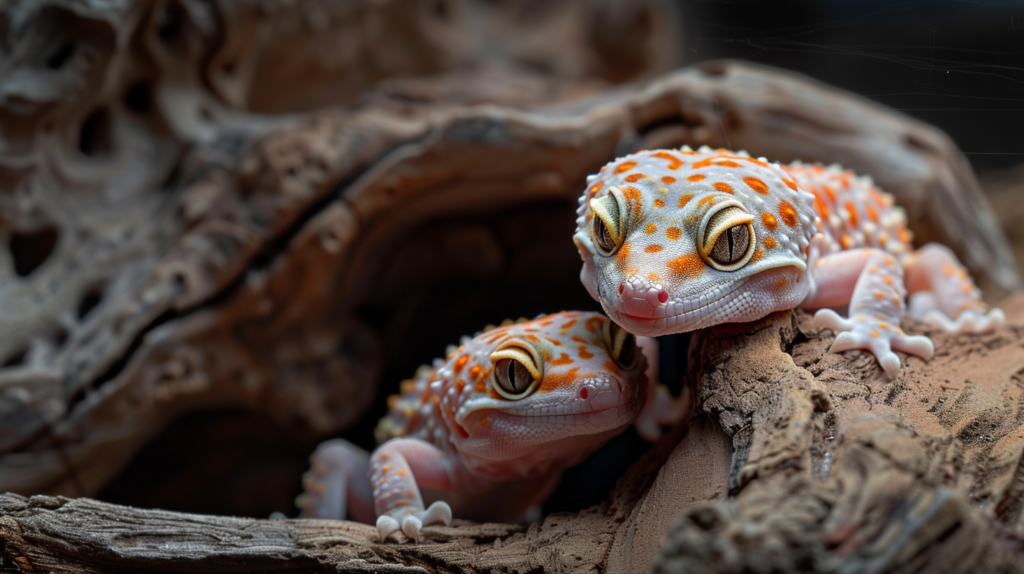
The genetics behind Mack Snow Leopard Geckos represent one of the most fascinating aspects of reptile breeding. Understanding these inheritance patterns is essential for anyone interested in breeding these remarkable animals or simply appreciating their genetic complexity.
The Mack Snow Gene
The Mack Snow trait follows an incomplete dominant inheritance pattern, which creates interesting breeding outcomes:
Heterozygous (Mack Snow): Animals carrying one copy of the snow gene display the classic snow appearance with reduced melanin and enhanced contrast.
Homozygous (Super Snow): Animals carrying two copies of the snow gene show even more dramatic coloration changes, often appearing nearly white with minimal pattern.
Breeding Combinations and Outcomes
| Cross Type | Expected Offspring Ratios | Appearance Description |
| Normal × Mack Snow | 50% Normal, 50% Mack Snow | Standard distribution |
| Mack Snow × Mack Snow | 25% Normal, 50% Mack Snow, 25% Super Snow | Includes super form |
| Super Snow × Normal | 100% Mack Snow | All offspring carry gene |
| Super Snow × Mack Snow | 50% Mack Snow, 50% Super Snow | No normal offspring |
Genetic Considerations
Line Breeding Effects: The quality and intensity of snow expression can vary significantly between different bloodlines. Reputable breeders maintain detailed records of genetic backgrounds to predict offspring characteristics.
Outcrossing Benefits: Introducing new genetic material helps maintain vigor and can enhance desirable traits while reducing the risk of genetic issues.
Selection Pressure: Breeders often select for specific traits like:
- Enhanced contrast between light and dark areas
- Consistent pattern distribution
- Optimal size and body condition
- Strong feeding response and health
Breeding Season and Reproduction
Mack Snow geckos follow typical leopard gecko reproductive patterns:
Breeding Season: Generally occurs from January through September in captivity, with peak activity in spring and early summer.
Egg Development: Females typically lay 2 eggs every 3-4 weeks during breeding season, with proper temperature and nutrition.
Incubation Requirements: Eggs require 45-60 days of incubation at 82-86°F for optimal development and sex determination.
According to breeding records from the Gecko Breeders Association, Mack Snow morphs show slightly reduced fertility rates compared to normal morphs, with successful breeding occurring in approximately 75-80% of attempted pairings versus 85-90% for normal morphs.
7. Housing and Environmental Needs
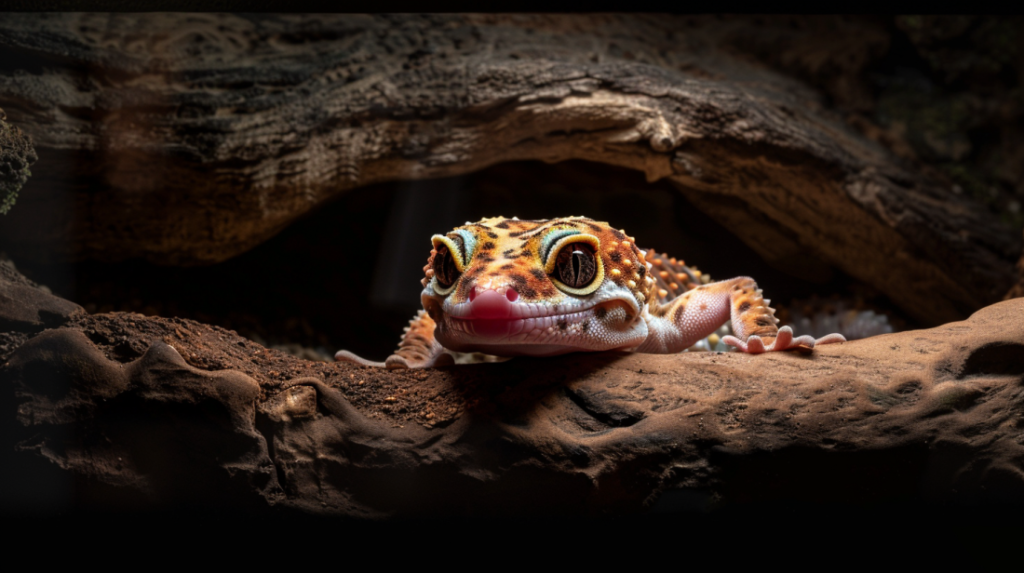
Creating the perfect environment for a Mack Snow Leopard Gecko requires understanding their specific needs while accommodating their natural behaviors. Proper housing setup directly impacts their health, behavior, and overall quality of life.
Enclosure Size and Setup
Minimum Space Requirements:
- Single adult: 20-gallon long terrarium (30″ × 12″ × 12″)
- Breeding pair: 40-gallon breeder tank or larger
- Multiple females: Add 10 gallons per additional female
Substrate Options: Research by reptile husbandry specialists indicates that substrate choice significantly affects gecko health:
Recommended Substrates:
- Paper towels (easy cleaning, safe for all ages)
- Reptile carpet (reusable, provides texture)
- Tile (natural appearance, easy maintenance)
- Cypress mulch (natural, maintains humidity)
Substrates to Avoid:
- Sand (impaction risk, especially for juveniles)
- Cedar or pine shavings (respiratory irritants)
- Calcium sand (marketed as “digestible” but still poses risks)
Temperature and Lighting Requirements
Temperature Gradient: Maintaining proper thermal gradients is crucial for thermoregulation:
- Warm side: 88-92°F (measured with probe thermometer)
- Cool side: 75-80°F
- Nighttime drop: 70-75°F throughout enclosure
- Basking spot: 95-100°F (optional but beneficial)
Heating Methods:
- Under-tank heaters (primary heat source)
- Ceramic heat emitters (supplemental heating)
- Radiant heat panels (efficient for larger enclosures)
Lighting Considerations: While Mack Snow geckos are primarily nocturnal, research suggests benefits from:
- Low-level UVB lighting (5-7% UVB tubes)
- Natural day/night cycle maintenance
- Red or blue nighttime viewing lights (minimal disturbance)
Humidity and Ventilation
Optimal Humidity Levels:
- General enclosure: 30-40% relative humidity
- Humid hide: 70-80% relative humidity
- Breeding females: Slightly elevated humidity during egg development
Ventilation Requirements:
- Screen top with adequate air circulation
- Avoid stagnant air conditions
- Monitor for condensation buildup
Essential Habitat Features
Hide Box Requirements: Provide at least three hide options:
- Warm side hide (security during digestion)
- Cool side hide (thermal regulation option)
- Humid hide (shedding assistance and moisture access)
Water and Food Areas:
- Shallow water dish (changed regularly)
- Feeding area away from substrate
- Easy-to-clean surfaces for maintenance
8. Health Considerations and Common Issues
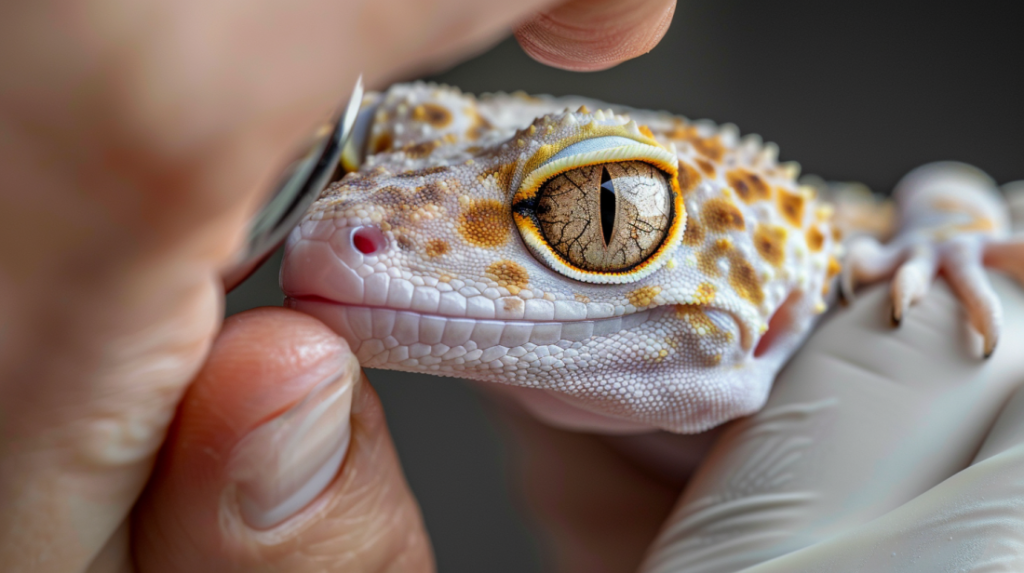
Maintaining the health of a Mack Snow Leopard Gecko requires understanding both general leopard gecko health issues and any specific concerns related to their unique genetics. Proactive health management significantly extends their lifespan and quality of life.
Common Health Issues
Shedding Problems (Dysecdysis): Mack Snow geckos may experience shedding difficulties, particularly around toes, tail tips, and eye caps. This condition is more common in environments with inadequate humidity.
Signs and Solutions:
- Stuck shed appears as tight bands around extremities
- Provide humid hide with damp moss or paper towels
- Gentle assistance may be needed for stubborn shed
- Never pull shed forcefully – this can cause injury
Metabolic Bone Disease (MBD): This preventable condition results from inadequate calcium supplementation or improper UVB lighting.
Prevention Strategies:
- Regular calcium dusting of feeder insects
- Appropriate UVB lighting when provided
- Proper temperature gradients for calcium absorption
- Avoid over-supplementation which can cause kidney issues
Impaction: Gastrointestinal blockages can occur from inappropriate substrate ingestion or oversized prey items.
Risk Factors and Prevention:
- Use safe substrate materials
- Proper prey sizing (no larger than gecko’s head width)
- Maintain appropriate temperatures for digestion
- Monitor feeding response and waste production
Genetic Health Considerations
Snow Gene-Related Issues: While generally healthy, some genetic combinations involving snow genes can produce health concerns:
Eye Development: Certain breeding combinations may result in visual impairments, though this is rare in well-bred lines.
Fertility Rates: Super Snow geckos may show slightly reduced breeding success compared to heterozygous animals.
Growth Rates: Some individuals may exhibit slower growth rates, requiring careful monitoring and nutrition management.
Preventive Health Care
Regular Health Monitoring: Weekly health checks should include:
- Weight monitoring (digital scale recommended)
- Appetite and feeding response assessment
- Skin and shed condition evaluation
- Behavioral pattern observation
- Waste production monitoring
Professional Veterinary Care: Establish relationship with exotic veterinarian experienced with reptiles:
- Annual wellness examinations
- Immediate consultation for health concerns
- Fecal parasite screening (especially for new acquisitions)
- Emergency care availability
Quarantine Protocols: New geckos should be quarantined for 90 days minimum:
- Separate enclosure and equipment
- Veterinary examination and testing
- Monitor for signs of illness or parasites
- Gradual introduction to collection
Health Statistics and Lifespan
According to data compiled by the Association of Reptilian and Amphibian Veterinarians, captive leopard geckos, including Mack Snow varieties, show impressive longevity statistics:
- Average lifespan: 15-20 years with proper care
- Maximum recorded lifespan: 28 years
- Common health issue prevalence: MBD (15%), shedding problems (25%), impaction (8%)
- Genetic issue incidence in snow morphs: Less than 2% when properly bred
Dr. Jennifer Walsh, an exotic veterinarian specializing in reptiles, states: “Mack Snow leopard geckos are remarkably hardy animals when provided with appropriate care. The vast majority of health issues we see are preventable through proper husbandry and nutrition.”
9. Lifespan and Long-term Care Commitment

Owning a Mack Snow Leopard Gecko represents a significant long-term commitment that can span two decades or more. Understanding the full scope of this commitment helps ensure both owner satisfaction and optimal animal welfare throughout the gecko’s extended lifespan.
Lifespan Expectations
Average Lifespan Statistics:
- Captive-bred Mack Snow geckos: 15-20 years
- Wild-type leopard geckos: 10-15 years (comparison)
- Record holders: Some individuals exceeding 25 years
- Factors affecting longevity: Genetics, diet, housing, veterinary care
Age-Related Changes: As Mack Snow geckos age, owners should expect several physiological and behavioral changes:
Years 1-5 (Youth to Prime Adult):
- Rapid growth and development
- Peak breeding potential
- High activity levels
- Stable feeding patterns
Years 6-15 (Mature Adult):
- Slower metabolism
- Reduced breeding frequency
- Pattern and color stabilization
- Continued robust health with proper care
Years 16+ (Senior):
- Decreased activity levels
- Potential vision or mobility changes
- Modified dietary needs
- Increased veterinary monitoring requirements
Long-term Housing Evolution
Adapting Care Over Time: Housing and care requirements may need adjustment as geckos age:
Juvenile Adaptations:
- Smaller prey items and more frequent feeding
- Enhanced security features to reduce stress
- Growth monitoring and enclosure size increases
Adult Optimization:
- Stable, established territories
- Breeding considerations and seasonal changes
- Mature feeding schedules and portion control
Senior Modifications:
- Easier access to food and water
- Softer substrates for joint comfort
- Simplified climbing structures
- Enhanced heating for metabolism support
Financial Considerations
Lifetime Cost Analysis: Understanding the financial commitment helps potential owners make informed decisions:
Initial Setup Costs:
- Terrarium and equipment: $200-500
- Initial veterinary examination: $75-150
- Gecko purchase price: $50-300 (depending on quality/genetics)
Annual Maintenance Costs:
- Food and supplements: $100-200
- Utilities (heating/lighting): $50-150
- Routine veterinary care: $100-300
- Substrate and supplies: $50-100
Total 20-Year Investment: Approximately $3,000-6,000, not including emergency veterinary costs or equipment replacements.
Building a Support Network
Essential Resources: Successful long-term gecko ownership benefits from established support systems:
Professional Support:
- Exotic veterinarian relationship
- Experienced reptile store or breeder for consultation
- Online communities and forums for advice
Emergency Planning:
- Pet-sitting arrangements for travel
- Emergency veterinary contact information
- Care instructions for temporary caregivers
Knowledge Maintenance:
- Staying current with husbandry best practices
- Participating in reptile communities and organizations
- Continuing education about gecko care and health
Legacy Planning Considerations
Responsible Ownership: Long-lived pets require consideration of changing life circumstances:
Life Changes:
- Moving and housing restrictions
- Family changes and time availability
- Health issues affecting care ability
- Financial changes impacting care quality
Rehoming Preparation: When necessary, responsible rehoming ensures continued welfare:
- Detailed care documentation
- Veterinary health records
- Appropriate new owner screening
- Gradual transition planning
According to a survey conducted by the Reptile Keepers Association, 85% of long-term leopard gecko owners report high satisfaction with their pets, citing their manageable care requirements and engaging personalities as primary factors in successful long-term relationships.
Creating the Perfect Environment:
Step-by-Step Setup Guide
Setting up the ideal habitat for your Mack Snow Leopard Gecko requires careful planning and attention to detail. This comprehensive setup guide will help you create an environment that promotes natural behaviors while ensuring your gecko’s health and happiness.
Step 1: Selecting the Right Enclosure
Size Specifications:
- Minimum: 36″ × 18″ × 18″ for adult geckos
- Preferred: 48″ × 24″ × 20″ for enhanced quality of life
- Material: Glass terrariums with secure, ventilated tops
Why Size Matters: Research by reptile behaviorists shows that larger enclosures promote:
- Increased natural behaviors
- Better thermoregulation opportunities
- Reduced stress indicators
- Enhanced physical conditioning
Step 2: Establishing Temperature Zones
Heat Source Installation:
- Install under-tank heater covering 1/3 of floor space
- Connect to thermostat for precise temperature control
- Place probe thermometer at substrate level
- Add secondary heat source if needed for ambient temperature
Temperature Verification:
- Use multiple thermometers to verify gradient
- Check temperatures at various heights
- Monitor for 24-48 hours before introducing gecko
- Adjust heating elements as needed for consistency
Step 3: Substrate Selection and Installation
Recommended Approach: Many experienced keepers use a mixed substrate system:
- Primary area: Reptile carpet or tile
- Humid hide area: Cypress mulch or moss
- Feeding area: Removable paper towels
Installation Tips:
- Ensure substrate depth allows for natural digging behavior
- Create slight depression for water dish stability
- Leave spaces for hide placement and accessibility
Step 4: Hide Box Placement and Selection
Essential Hide Types:
Warm Side Hide:
- Position over heating element
- Ensure snug fit for security
- Easy access for cleaning
Cool Side Hide:
- Place in coolest area of enclosure
- Similar size and style for consistency
- Multiple entry points beneficial
Humid Hide:
- Central location for accessibility
- Sealable container with entrance hole
- Filled with damp moss or paper towels
Step 5: Lighting and Day/Night Cycle
Lighting Setup:
- Timer-controlled lighting for consistency
- Optional low-level UVB for enhanced wellbeing
- Red or moonlight LED for nighttime viewing
- 12-hour day/night cycle year-round
Step 6: Water and Feeding Areas
Water Station:
- Shallow dish preventing drowning risk
- Easy-to-clean material (ceramic or glass)
- Positioned away from heating elements
- Regular water changes (2-3 times weekly)
Feeding Area:
- Designated feeding location
- Easy substrate cleanup
- Away from hiding areas to encourage foraging
For more expert pet care tips and product recommendations, visit BlithePet.com — your trusted source for pet wellness.
Frequently Asked Questions
What makes a Mack Snow Leopard Gecko different from regular leopard geckos?
The Mack Snow Leopard Gecko differs from regular leopard geckos primarily in their coloration and genetic makeup. The snow gene reduces melanin production, creating a distinctive appearance with lighter base colors (white, cream, or light gray) and more muted banding patterns. While their care requirements remain essentially the same as normal leopard geckos, Mack Snow varieties often command higher prices due to their unique appearance and the selective breeding required to produce them. The gene also allows for the creation of “Super Snow” morphs when two snow genes are present.
How much does a Mack Snow Leopard Gecko typically cost?
Mack Snow Leopard Gecko prices vary significantly based on several factors including genetics, breeder reputation, and specific traits. Pet-quality animals typically range from $75-200, while high-quality breeding animals can cost $300-800 or more. Super Snow varieties and those with exceptional traits or rare genetic combinations may command even higher prices. Additional costs include initial setup ($200-500) and ongoing care expenses. It’s important to purchase from reputable breeders who provide health guarantees and genetic information.
Can Mack Snow Leopard Geckos be housed together?
Housing multiple Mack Snow Leopard Geckos together requires careful consideration of several factors. Adult males should never be housed together due to territorial aggression. Females can often cohabitate successfully if provided with adequate space (40+ gallons for two females), multiple hiding spots, and separate feeding areas. However, many experienced keepers prefer individual housing to reduce stress, prevent competition for resources, and allow for better health monitoring. Breeding pairs should only be housed together during breeding season under close supervision.
What are the signs of a healthy Mack Snow Leopard Gecko?
A healthy Mack Snow Leopard Gecko displays several key characteristics: bright, clear eyes without discharge; clean, well-formed shed cycles; steady weight maintenance; regular feeding response; normal waste production; alert, responsive behavior; and clear, unblemished skin. They should have a plump tail that serves as fat storage, indicating good nutrition. Healthy geckos are active during evening hours, explore their environment, and show curiosity about their surroundings. Any changes in appetite, behavior, or appearance warrant veterinary consultation.
How often should I feed my Mack Snow Leopard Gecko?
Feeding frequency for Mack Snow Leopard Geckos depends on age and individual needs. Juveniles (under 12 months) should be fed daily with 5-7 appropriately sized insects. Adults can be fed every other day or 3-4 times weekly with 7-10 insects per feeding. Prey should be no larger than the width of the gecko’s head. All feeder insects should be gut-loaded 24-48 hours before feeding and dusted with calcium powder 2-3 times weekly and multivitamins once weekly. Overfeeding can lead to obesity and health issues.
Do Mack Snow Leopard Geckos require special veterinary care?
While Mack Snow Leopard Geckos don’t require specialized veterinary care beyond what’s needed for other leopard gecko morphs, it’s essential to work with a veterinarian experienced in reptile medicine. Annual wellness examinations help detect potential issues early. New geckos should receive veterinary examination and fecal parasite screening. Emergency situations requiring immediate veterinary attention include refusal to eat for more than two weeks, difficulty shedding, apparent pain or distress, abnormal waste production, or any sudden behavioral changes. Establishing a relationship with a qualified exotic veterinarian before emergencies arise is crucial.
Conclusion
The Mack Snow Leopard Gecko represents one of the most rewarding reptile companions available to both novice and experienced keepers. Their striking appearance, docile temperament, and manageable care requirements make them exceptional pets that can provide decades of enjoyment and fascination.
Throughout this comprehensive guide, we’ve explored the nine essential traits that make these geckos truly special: their distinctive snow-white coloration, unique eye characteristics, predictable growth patterns, gentle temperament, specific dietary needs, fascinating genetics, environmental requirements, health considerations, and long-term care commitment. Understanding these traits provides the foundation for successful, long-term gecko ownership.
The commitment to caring for a Mack Snow Leopard Gecko extends far beyond their initial appeal. These remarkable animals can live 15-20 years or more with proper care, making them true companion animals that become integrated into family life. Their relatively simple care requirements, combined with their engaging personalities and stunning appearance, create a uniquely satisfying pet ownership experience.
Whether you’re drawn to their genetics, captivated by their appearance, or seeking a manageable yet fascinating reptile companion, the Mack Snow Leopard Gecko offers an exceptional opportunity to connect with the natural world. By providing appropriate housing, nutrition, and veterinary care, you’ll be rewarded with a healthy, active gecko that demonstrates the remarkable adaptability and charm that has made leopard geckos one of the world’s most popular reptile pets.
Remember that successful gecko keeping is built on education, preparation, and ongoing commitment to learning. Stay connected with the reptile community, maintain relationships with qualified veterinarians, and continue expanding your knowledge as husbandry practices evolve and improve.
Have a similar experience with your pet? Share it in the comments below!



